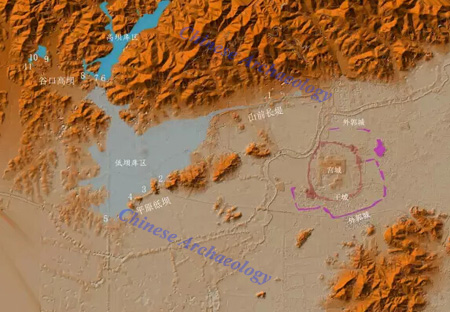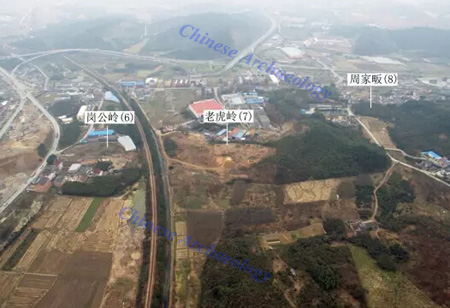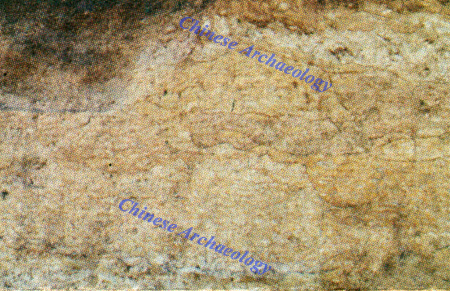5000-year-old Large-Scaled Water management System around the Ancient Walled Settlement of Liangzhu Culture found
From:Chinese Archaeology NetWriter:Date:2016-05-17
According to the long-term investigations and research of the overall structure of the ancient walled settlement of Liangzhu culture by Zhejiang Provincial Institute of Culture and Archaeology, a large-scale sophisticated hydraulic system consists of more than ten dams connecting with mountains was found around the ancient walled settlement.
The plan of ancient Liangzhu city and its large-scale hydraulic system
To fulfill the academic goals such as to understand the dam structure, formal excavation was carried out to the dams located in Laohu Mountain, Liyu Mountain, Shizi Mountain…etc. from July 2015 to January 2016 by Zhejiang Provincial Institute of Culture and Archaeology. The results have confirmed the distribution of the hydraulic system, obtained the valuable information about the dam structure and construction technology, as well as the stratigraphic sequence to proof the dating of the dam, which verified the reliability of the results of C14 dating.

Aerial photo of Gangongling-Laohuling-Zhoujiafan from north to south
The Long Dyke along the piedmont:
It is originally called Tangshan site or Tuyuan site, located 2km north of Liangzhu ancient walled settlement, with the total length of 5km from the northeast to the southwest, which is the largest individual among the hydraulic system. It can be divided into three parts from the west to the east. The west part is rectangular single layer structure, and the middle part is south-north double layer structure.
The High Dam Building at the Entrance of the Valley:
It locates at the entrance of the valley of the mountains on the higher part of the northwest, including six dams such as Ganggong Mountain, Laohu Mountain…etc. It can be divided into the east group and the west group, each blocking a valley and forming a reservoir. The high dam has a height of about 30-35 metres and a thickness of nearly 100 metres.
The Low Dam Connecting the Plain and the Mountain:
It locates around 5.5km south of the high dam on the plain, formed four dams through connecting the mountains of Wutongnong, Guan Mountain, Liyu Mountain, and Shizi Mountain on the plain. The height of the dam is around 10 metres. The high dam and the low dam have formed a triangular area of around 8.5 square kilometres.

Structure chart which showed the dam body of Liyu Mountain
Excavation Results
Small scale excavations were carried out at the low dams of Shizi Mountain and Liyu Mountain, as well as the high dam of Laohu Mountain in 2015. The total excavation area is 490 square metres.
Shizi Mountain:
According to the excavation, the artificial rock pile is about 123 metres wide and around 10 metres deep, with no signs of the appearance of grass wrapped mud and rammed earth. A piece of sandy clay ware of Liangzhu culture was uncovered inside the dam body.
Liyu Mountain:
The dam was built by digging a longitudinal groove under the ground with the width of 25 metres and the depth of 3 metres. It was filled the groove with green mud and grass wrapped mud, hence, cover a layer of loose yellow soil on top. The grass wrapped yellow soil and the loose yellow soil were used to form a slope at the north part.
As Carp Mountain locates on the plain and the soil perviousness is poor, and the soil is easy to erode, hence the dam could collapse easily. Therefore, the groove that filled with mud could be used to prevent the leakage. Many pottery pieces of Songze culture period and a pottery piece of Liangzhu culture were found inside the filling.

The distribution of grass-mud wrap
Laohu Mountain:
Two trial trenches were arranged respectively, one is at the junction between the west side of the dam and the mountain and another one is on the north side of the dam. The total excavation area is 70 square metres. Important stratigraphic information was obtained. It is found that ditch 3(G3) of the trench T1 on the west side breaks the western most end of the dam and it belongs to late Liangzhu period. Many pottery pieces of Liangzhu period were uncovered in the ditch. However, the ditch itself is broken by the ditch G2 of Maqiao period.
The dam was built firstly by making the foundation with green mud and the grass wrapped mud on the ground of the bottom of the valley; hence, the green loose soil was piled on the foundation; a slope was then made of grass wrapped yellow soil and yellow loose soil on the north part and face to the water; yellow brown loose soil was used to make the revetment; and finally brown soil was used to cover the top.
According to the section, grass wrapped mud has clear partition phenomenon, which indicates that the transport capacity from each location was for weekly use, the grass wrapped mud came from different locations, and it was used once it arrived. There is no unified pile process. Therefore, the grass wrapped mud of each section could be kept unified and hence formed the clear block.
Dating
According to the stratigraphy and C14 dating, the hydraulic system belongs to the early-middle Liangzhu period.
Stratigraphic Evidence:
Two royal tombs of Liangzhu period and a jade processing site were found on the top of Tang Mountain that indicates the site belongs to a time period no later than the Liangzhu period. Also, the excavation of the high dam of the Tiger Mountain gives the stratigraphic evidence showing that the dam body cut into the late Liangzhu period layer. The stratigraphic layer of the low dam of Carp Mountain is cut by a tomb of the Warring States. The pottery pieces of Liangzhu culture were uncovered from the Carp Mountain Dam and the Lion Mountain Dam, on the other hand, some pottery pieces of Liangzhu culture were also found in Bee Lane Dam and Ganggong Mountain Dam during early research. Moreover, there is no artifact found from the fillings of the dams belongs to the time periods later than the Liangzhu period.
C14 Dating Data:
Samples from seven out of eleven dams were dated by C14 dating in the chronological lab of Peking University. Twelve results were obtained, which relate to six locations including Ganggong Mountain, Carp Mountain, Lion Mountain, Tiger Mountain, Zhoujia Field, and Autumn Dock. According to the results, the dendrological calibration results of all the samples are between 4700 to 5100 years up to the present day, which belongs to the early and middle Liangzhu cultural period.
Techniques and Functions
As the long dyke and the high and low dams have different functions, the structure and construction techniques are different.
According to the excavation, the foundations of most high and low dams were built by piling up the mud. A groove was normally dug with mud filled in and yellow soil and grass wrapped mud supported at the soft part of the foundation. The building technique used is same as building the palace of Liangzhu period at Mojiao Mountain. Also, some important locations of the dam were reinforced by the yellow soil and grass wrapped mud, which is the common construction technique used for building platforms and riverbanks of Liangzhu period. The function of this technique is same as the bagged soil used in the constructions of modern dykes and dams, which increases the intensity of tension to make the body more stable.
It is suggested that this hydraulic system might have compositive functions such as flood control, transportation, water use, irrigation…etc. It was strongly connected with the production and daily activities of the Liangzhu settlement and its surroundings.
Flood Control Function:
A large amount of water could be kept inside the valley and the lower ground based on the high and low dams of the hydraulic system in order to control the flood.
Transportation:
The Tianmu Mountain is rich in resources, which have provided various jade, stone, wood, lacquer, and other animal and plant resources to the Liangzhu settlement group. Water transportation was the easiest transportation way during the Liangzhu period as the wheel transportation and the road systems have not emerged yet. The Liangzhu people have built a large amount of artificial canals both inside and outside of the city at the same time as building the hydraulic system, in order to connect the natural water of the plain area and hence to form a complicated and complete water transportation network.
Different hydraulic systems were built by the Liangzhu people in the upper, middle, and lower river areas. This indicates their abilities on planning and changing of hydrographic environments. Massive works need to be carried out when building a hydraulic system; the total earth volume of the outer part could be 2600,000 square metres. The large-scale hydraulic system involves complex organizations and also requires labour management and social appeal abilities. It contributes a new important perspective to the understanding of the administrative organisations of the ancient walled settlement of Liangzhu culture and its social complexity.
Academic Significance
The hydraulic system of Liangzhu culture is the earliest large-scale hydraulic system found in China. The recovery of the 5000-years-old hydraulic system is very important to the investigation of ancient Chinese hydraulic history. It is also the earliest flood control system in the world, which gives a clear comparison to the hydraulic systems of ancient Egypt and Mesopotamia that were mainly built to conduct water such as the irrigation channels and cisterns. It has also indicated the difference between the rice-based civilisation of the East and the wheat-based civilisation of the West.
The hydraulic system has also proved that the ancient walled settlement of Liangzhu culture had a complete capital city structure with palace wall, inner city wall, outer city wall, and with the hydraulic system surrounded outside the city. This structure has strongly influenced the constructions of capital cities in later periods, which provides significant research information for the investigation of the Chinese city history.
One of the earliest state patterns in China appeared in the area where the ancient settlement of Liangzhu culture located. This is the evidence for 5,000 years of Chinese civilization. The hydraulic system outside the walled enclosure and the settlement has an inextricable relationship in space and time. The recovery of the hydraulic system outside the walled enclosure has significantly contributed to the investigation of the appearance and development of the early state of Liangzhu and the origin of Chinese civilization. Moreover, it is also important to the research of the history of world civilizations. (Translator: Li Xuelei)

